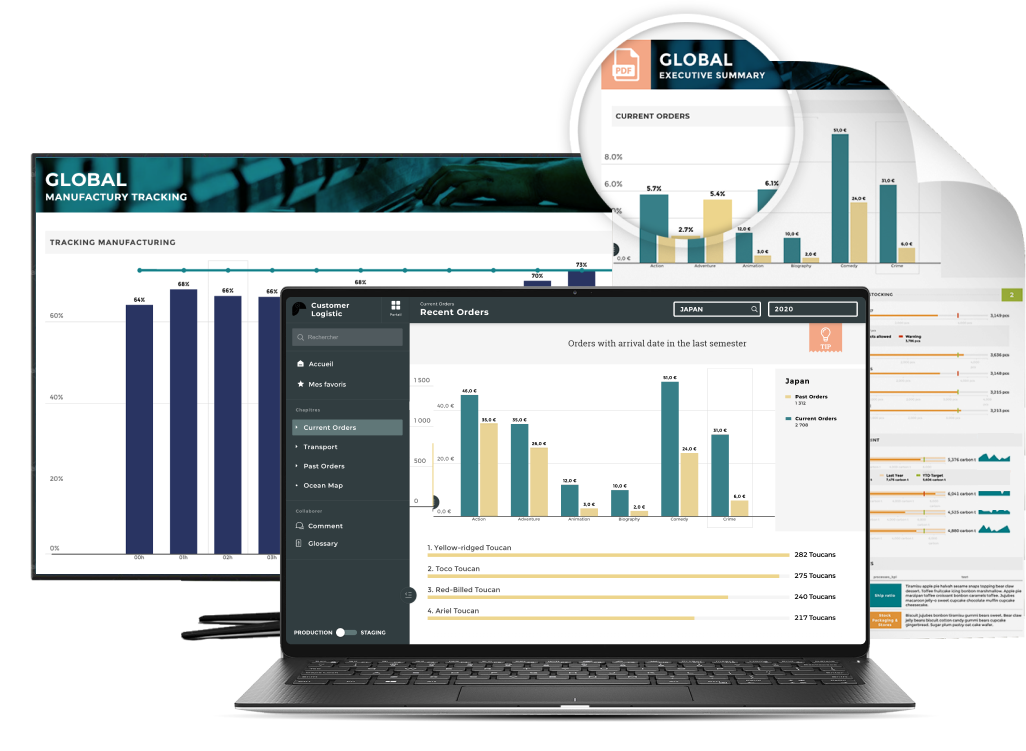A real estate Key Performance Indicator (KPI), or metric, is a quantifiable measure that can be used to assess the performance of a business, investment, or individual operating in the real estate industry.

These metrics can be used in a number of ways, with the ultimate goal generally being to drive more strategic, data-driven decision-making and improved business outcomes.
Virtually anyone involved in the real estate industry can (and probably should) be taking advantage of the insights that their data (and subsequent real estate KPIs) can provide for their businesses. These figures track far more than simple sales data, encompassing everything from leasing, to management, to development.
So, yes, real estate KPIs are relevant whether you’re an investor, an agent, or a real estate developer. In this post, we dive into some of the ways that specific real estate KPIs can help you, regardless of your role in the space, and the benefits that leveraging a guided analytics framework can have in helping you make the most of your data.
Let’s jump in!
KPIs real estate agents should be tracking
Similarly to the other KPIs we'll be covering in this article, there are soooo many that you can choose from, as a real estate agent, to measure and optimize your (or your teams’) performance.
While this isn’t a comprehensive list of all the metrics you could be tracking as an agent, we find that they’re some of the most important ones to get a grasp on:
-
Appointment to Listing Conversion Rate:
This KPI illustrates the percentage of appointments an agent makes with potential sellers that actually turn into active listings.
Appointment to listing rates can be particularly helpful in determining the number of appointments you or your team need to make to achieve your targets. The conversion rate becomes more impactful, as with many other metrics, depending on how much data you have available to you (it becomes increasingly reflective of actual conversions vs seasonal or market changes over time).
To calculate this KPI, you can use the following formula:
Appointment to Listing Conversion Rate = (Total Number of Listings / Total Number of Appointments) * 100
-
Average Commission per Sale
This KPI can be very motivating, helping you understand how much you can expect to make from a sale, as well as helping you to identify top performers and learn from their best practices. Moreover, because selling properties takes significant investments in both time and resources, you’ll want to understand how to optimize your commissions and increase them over time. The formula for calculating this KPI is as follows:
Average Commission per Sale = Total Commission Value / # of Sales
-
Sold Homes per Available Inventory
This metric can be particularly useful in enabling teams to better understand current market conditions, as well as in helping adjust expectations and forecasts accordingly. To calculate sold homes per available inventory, you can use this formula:
Sold Homes per Available Inventory = Total # of Homes Sold / Total # of Homes Listed
-
Listings Closed
It’s likely obvious, but listings closed reflect the total number of closings you have over a given time period. It can be one of the most telling KPIs with regard to changes in profit and can be very useful for teams to compare over varying time periods to predict growth and success moving forward.
-
Number of Days on Market
This is another KPI that’s helpful for tracking market conditions and, Similarly, you can use this figure to adjust prices depending on those conditions. Sellers may be, for example, more willing to adjust prices if the time on market is longer, helping you close quicker and allocate your resources to more efficient projects.
Check out this article from Geckoboard for a deeper dive into KPIs that are particularly relevant for real estate agents.
KPIs real estate investors should be tracking
There is a litany of metrics that can support you, as a real estate investor, in turning your projects into financially healthy (and profitable) endeavors.
And again, while this isn’t a comprehensive list of all the metrics you could be tracking as an investor, these are some of the ones that our clients in the industry use to help them with their investment decisions.
-
Return on Investment (ROI)
If you’re an investor, ROI likely isn’t a metric that’s new to you. Nonetheless, it's important. If you’re making an investment, regardless of whether it's in real estate or something else entirely, you’ll want to know how well it performs (or how well it performed in the past). Here’s a basic ROI formula:
ROI = (Net Profit / Total Investment) * 100
-
Net Operating Income (NOI)
NOI shows you how much money you make from a given investment property and is, in essence, a version of a high-level income statement. NOI calculations account for your total income minus your operating expenses (excluding capital expenditures, taxes, mortgage payments, and interest).
NOI = Total Income - Operating Expenses
-
Internal Rate of Return (IRR)
IRR helps you estimate the interest that you will earn on each dollar you invest in a property, over that property’s holding period. This means that IRR helps you understand the potential growth rate for a property, as well as its estimated long-term yield. While IRR can be really helpful, keep in mind that it assumes rental stability and doesn’t account for unforeseen factors such as repairs on your investments. Investopedia has a great resource to help you understand and calculate your IRR.
-
Cash Flow
Cash flow is a really important metric for investors to have in mind because, though simple, it indicates how well your business is performing.
Cash flow is the amount of net cash you have at the end of a given period after you’ve received all your rental payments and paid all your expenses. If you have a negative cash flow, you won’t be able to pay your bills or make a profit (and it might indicate that you’re overspending on an investment).
-
Gross Rent Multiplier (GRM)
GRM helps you, as an investor, compare potential or existing investments and come up with a property’s worth. GRM is influenced by the market, as well as comparable properties. GRM is very useful, but make sure that your investment decisions aren’t driven solely by this KPI (since it doesn’t account for vacancies or other expenses).
GRM = Property (or Investment) Price / Gross Rental Income
-
Tenant Turnover
Tenant Turnover refers to the proportion of tenants that vacated a property versus those that stayed or renewed for a given rental period. The goal of successful investors is, unsurprisingly, to reduce tenant turnover as much as possible to minimize the loss of rental income due to the vacancy of the property; tenant turnover can kill profitability, especially due to the process of getting a property ready for a new tenant after a lease expires and the previous tenant moves out.
KPIs real estate developers should be tracking
Real estate development projects are, virtually always, high-risk. Fortunately, there are many developer-specific KPIs that help successful development teams better understand market conditions, and control and optimize costs.
We'll say it again: this isn’t a comprehensive list of all the metrics you could be tracking as a real estate developer, but they’re some of the most important ones to have a grasp of to better manage your projects:
-
Internal Rate of Return (IRR)
We showed you this metric before, but it’s important for developers just as it is for investors. IRR can help you assess the attractiveness and financial viability of a real estate project. Most developers have an idea of what their required IRR is, so if the calculation comes up higher than what they have in mind, the project is more attractive.
-
Interest Coverage Ratio
This ratio is important because most real estate developers don’t develop properties with cash they have on hand (instead, they generally elect to take out loans). The minimum that you’re therefore required to pay if that’s the case for you will be the interest on your loans, which is what interest coverage is all about; it helps you measure your ability to cover expenses with your earnings before interest and taxes (EBIT).
Interest Coverage = EBIT / Interest Expenses
-
Real Estate Demand Growth
Market conditions are important, and this is especially true for real estate developers. Understanding demand in the area(s) in which you want to invest is one of the most important drivers behind starting successful projects. And while we understand that forecasting demand is difficult, it’s not impossible. You can forecast demand by using a number of factors that are contextually relevant, whether it's population trends, construction permit ecosystems, or mortgage application growth rates.
-
Construction Cost per Square Foot
When investing in large-scale development projects, it's important to understand how much you are paying per square foot and, similarly, how much construction will cost for that space. Construction cost per square foot is particularly helpful for generating project budgets and determining sale prices for your units.
Construction Cost per Square Foot = Total Construction Cost / Total Area
-
Profitability per Square Foot
Another per-square-foot measure, this metric can be helpful in making sure your project(s) will actually generate enough cash for you to attain profitability. It’s another KPI that is frequently leveraged by successful real estate developers.
How many KPIs should you track?
The KPIs we’ve listed above can all be impactful in the right context. But there are so many metrics to keep an eye on which are, at best, inefficient to manage and, at worst, impossible to manage.
So, since monitoring too many KPIs can be overwhelming, it makes sense to invest in tools that help you keep track of the right metrics, at the right time, in the right place, efficiently and cost-effectively.
Guided analytics for real estate professionals
Tracking and optimizing the real estate metrics that are most relevant to your objectives is one of the most important factors behind driving consistent improvements (and growth), especially in the modern context.
Yet while the importance of data is widely accepted, today's real estate professionals often aren't getting the value they expect from their investments in analytics.
That's largely because, in our attempt to make analytics fast, powerful, all-seeing, and all-knowing, we've also made them incredibly hard to use. So complex that only experts can make something of their data.
So it's vital that those analytics are made easier for whatever your real estate-related need may be. And that's what we call Guided Analytics: analytics that assist users in understanding data and using that data to collaborate and drive results.
Some of the things to look for when considering guided analytics?
- A map of where you need to go: implement analytics that help you understand what you're seeing and why, everywhere, always. That means context, glossaries, and easily understood interactive charts.
- Collaboration: try to enable data-driven conversations with built-in collaborative environments that can be shared anytime, and universally on any device.
- Share-ability: your reports need to show up exactly where they're needed. That means PDF reports on schedule, wall displays, embedded within your applications, and mobile on phones and tablets.
Toucan is a customer-facing analytics platform that empowers companies to drive engagement with data storytelling. Ranked the #1 easiest to use analytics solution on G2 Crowd, their no-code, cloud-based platform cuts custom development costs with a quick and easy implementation, even for non-technical builders. To find out what our users say, read their reviews on G2 crowd.






